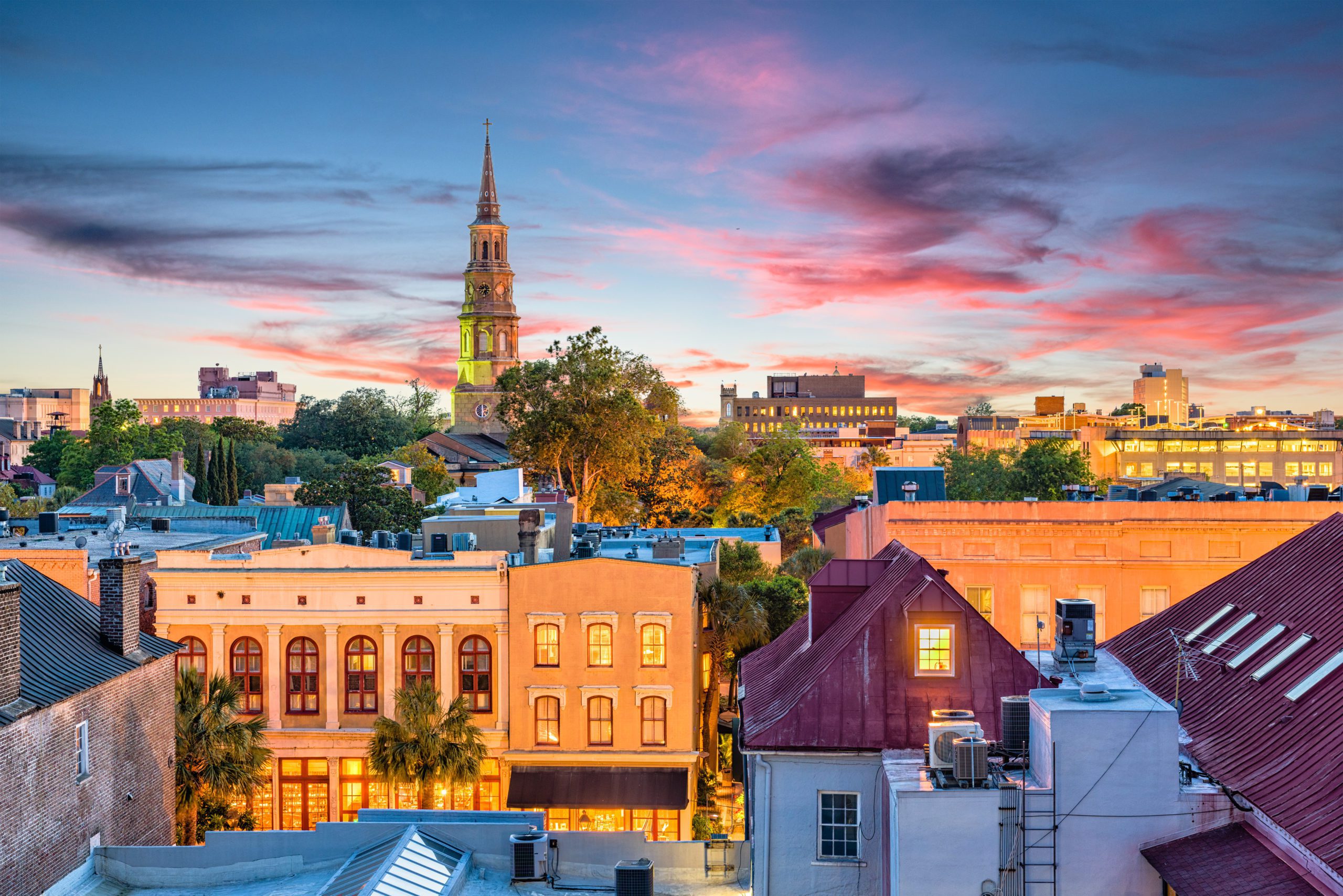
Whether you’re here on vacation or visiting family and friends, there’s no denying that Charleston is one of the most fascinating cities in the United States. From its interesting history to its amazing food scene, this charming southern city offers something for everyone, no matter what time of year it is. If you’re going to be visiting Charleston any time soon, check out these must-see historical spots in Charleston and start planning your trip today.
The Old Exchange & Provost Dungeon History
Built-in 1771, The Old Exchange is a remnant of colonial Charleston. This landmark is the site of some of the most important events in Charleston’s history. The exchange served as an early meeting hall, before its use as a jail during and after the Civil War when it was called The Provost Dungeon. This dungeon housed American prisoners of war, enslaved peoples, and British soldiers in extremely harsh conditions. The Exchanged was also used as the city’s most popular slave auction where African Americans were bought and sold to wealthy landowners throughout South Carolina and Georgia. The Exchange was reconstructed and reopened as a museum following restoration efforts in 1969. Today you can see artifacts from these historical periods displayed in the museums on-site. At The Old Exchange, you can tour a unique historic site with fascinating stories to tell. You can learn about America’s complicated past, through an interactive display that gives insight into slavery and segregation during these eras. If you’re looking for a piece of history or just interested in learning more about what went on here, make sure to check out The Old Exchange & Provost Dungeon History. There’s plenty here for everybody to enjoy.
Fort Sumter at Liberty Square
Fort Sumter is a civil war landmark and an important stop on any trip to Charleston. This iconic historic landmark is home to the first shots of the civil war and still stands as part of Liberty Square. On April 12, 1861, Confederate forces bombarded Union troops stationed at Fort Sumter; it was one of many battles that would define our country over the next four years. This island fortification served as headquarters for both armies during their respective occupations of Charleston during the War. Lying between downtown Charleston and Sullivan’s Island, Fort Sumter remains one of the most significant Civil War landmarks and attractions still standing. Today, visitors can tour Fort Sumter while learning about its role during extremely pivotal moments throughout the United States history. Tours are available at Liberty Square throughout most of the year. Visitors can experience a 2 hour Fort Sumter tour which includes a boat ride to and from the island and a self-guided audio tour once they arrive there. If you want the chance to experience US history up close, touring Fort Sumter is definitely a must when visiting Charleston.
Historic Charleston City Market
Located on Meeting Street, Charleston City Market was established in the 1790s by Charles Cotesworth Pinckney. With various stalls providing everything from souvenirs to food, you can spend hours perusing both its vendors and architecture. This three-block market is home to more than several eateries including City Market Grocery, a popular spot for locals to grab a coffee, pastries, and sandwiches; Peninsula Grill and Hank’s Seafood Restaurant which has been voted the best Seafood Restaurant in Charleston for the past 16 years. The Market is also famous for the open-air sheds. These open-air sheds are home to all kinds of great local artisans selling their handmade goods. Some of the vendors you might see selling there are Bev’s Sweetgrass Baskets, Carolina Islands Soap Works, Charleston Leatherworks, and ELEMENT Candles Inc. This bustling market provides a great opportunity to shop locally while getting an inside peek at Charleston culture. Because of its historical significance, Historic Charleston City Market has become one of Charleston’s most iconic landmarks.
St. Michael’s Episcopal Church Charleston
St. Michael’s Episcopal Church Charleston is a parish church located at 71 Broad St. in Downtown Charleston. Its present building was constructed from 1751 to1761 and is one of South Carolina’s oldest religious edifices still in use for its original purpose. Designated as National Historic Landmark by the U.S., This massive church features Georgian architecture with a massive steeple & cedar pews. In 1791 President George Washington visited and worshiped in the church pew illuminating the church’s historical significance. Visitors from all over the country and even other countries, such as England, France, and Italy come to visit & admire these pieces of America’s history. Despite much damage sustained during a hurricane that hit Charleston around 1710, The Parish Hall boasts beautiful stained glass windows showcasing delicate architectonical work inspired by European designs which depict biblical scenes. Make time to visit this historical site in Charleston as nothing but treasure lies within these walls both physically and historically so don’t miss out on visiting.
Charles Towne Landing State Historic Site
Charles Towne Landing State Historic Site is a museum and recreation area commemorating South Carolina’s founding by English colonists. The site features the original foundations of Charles Towne, the first colonial settlement in South Carolina, and a visitor center. A short trail winds through an oak hammock with river views. While there, you can visit the interactive museum at the visitor’s center and then walk through a self-guided historic trail tour using audio. You can also discover the wharf where settlers landed in 1670 as well as the trading ketch, Charleston’s only 17th-century replica ship. This will be the highlight of your visit as you actually will be able to board The Charles Towne Landing boat. A replica of a 17th century English trading ketch, the boat offers visitors an opportunity to learn about harbor life. You can also explore Fort Johnson, a defensive fort that was built during Charles Towne’s earliest days as an English colony. Visitors may also choose to enjoy various other self-guided walking tours or participate in living history activities throughout each season. Whether you are looking for a fun day outing with family and friends or an opportunity to better understand the city’s rich history –head out to one of South Carolina’s most historically significant sites—Charles Towne Landing State Historic Site.
Old Slave Mart Museum
A part of the U.S’s dark history. Slavery was once an integral component of Charleston’s economy and society. At one point, nearly half of South Carolina’s population consisted of enslaved people. The Old Slave Mart Museum in Charleston exhibits the cities involved in this brutal system from 1856 to 1863. Located on Chalmers St., this quaint building features items used during slavery times as well as detailed explanations of how they were used during the era Today, it stands as a sobering memorial dedicated to telling slaves stories through photographs, text panels, and objects that include shackles used for binding slaves for sale; an original slave box where enslaved people were kept before being auctioned off; handcuffs used by their owners and much more. You can tour the facility with a museum guide or explore on your own via touchscreen stations throughout. The tours provide detailed information about the auctions that took place and their effect on society, If you are interested in learning more about this time period in America then make it a point to visit the Old Slave Mart Museum.
Magnolia Plantation & Gardens
Magnolia Plantation and Gardens, one of South Carolina’s most popular historical sites, is a must-see for history buffs. The plantation was built circa 1676 by Thomas and Ann Drayton. Originally known as a rice plantation, the grounds became known for their gardens in the 1840s after the Reverend, John Grimke-Drayton inherited and converted the grounds. Today you can tour the mansion, which was turned into a boarding house during Reconstruction, complete with room furnishings and period decor. You can also take a walking tour of its expansive grounds that feature plenty of period buildings including slave quarters and smokehouses, as well as gardens filled with plenty of magnolias. If you want to see what life was like on a plantation and admire botanical life, then Magnolia Plantation and Gardens might be the perfect trip for you. At about 20 minutes north of downtown Charleston, not only do visitors get to learn about some important chapters in American history—the site gives them an opportunity to see how slaves lived as well. Add Magnolia Plantation & Gardens if you are looking for a dive into Charleston’s deep history
Drayton Hall- South Carolina
One of South Carolina’s most popular tourist destinations, Drayton Hall was built circa 1738. This legendary plantation house has survived both the revolutionary and civil war. Along with it being a historical landmark, it’s also a museum that’s open to visitors year-round. This museum features are 18th- and 19th-century objects and artifacts that range from furniture pieces and silverware to slaves’ tools used for farming. While at Drayton Hall, be sure to participate in a guided tour by one of their professional tour guides that show you each room step-by-step explaining its history and significance. There is also an option for self-guided tours where you get audio headsets to listen to informational facts as you walk through each room. The grounds have not been left out either. They have trails perfect for walking and exploring the beautiful live oak trees and breathtaking views. Whether you prefer strolling on the trail or taking your time learning about how the people of Drayton Hall lived, there will surely be something for everyone.
If you’re vacationing in Charleston, South Carolina, you’ll have plenty of historic sites to visit and lots of activities to choose from while you’re here. From Fort Sumter to St. Michael’s Episcopal Church, there are plenty of places to visit in Charleston, so be sure to start your planning early so you can make sure to visit every site on your itinerary.
Check out the Avelo Route Map for more information on Flights to Charleston, SC.

